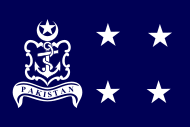Hasan Hafeez Ahmed
Vice-Admiral Hasan Hafeez Ahmed (Urdu:حسن حفيظ احمد; b. 1926-8 March 1975:329[2]), TQA, usually shortened to H.H. Ahmed, was a three-star rank admiral who served as the first Chief of Naval Staff (CNS) of Pakistan Navy from 1972 until his death in 1975.[2]
Hasan Hafeez Ahmed | |
|---|---|
| Chief of Naval Staff of Pakistan Navy | |
| In office 3 March 1972 – 9 March 1975 | |
| Preceded by | Muzaffar Hassan |
| Succeeded by | Mohammad Shariff |
| Personal details | |
| Born | Muzaffar Hassan 1926:3[1] Multan, Punjab, British Indian Empire Present-day Pakistan |
| Died | 1975 (aged 48–49) Karachi, Sindh, Pakistan |
| Citizenship | British Subject (1926–1947) Pakistan (1947–1975 |
| Awards | Tamgha-e-Quaid-e-Azam (1965) |
| Military service | |
| Nickname(s) | H.H. Ahmed |
| Branch/service | |
| Years of service | 1945–1975 |
| Rank | |
| Unit | Navy Executive Branch |
| Commands | Commander Coast (COMCOAST) Comdnt. Cadet College Petaro |
| Battles/wars | World War II
|
Despite appointed to the four-star appointment, he was retained at the three-star rank and took over the command of the Navy from its Commander Vice-Admiral Muzaffar Hassan who was dismissed from the military service.
Biography
Hassan Hafeez Ahmad was born in Multan, Punjab, British India, in 1926.:3[1] in an Arain Family. He was educated in a local school in Multan and was a contemporary of Mansoor Shah who would later joined the Pakistan Air Force in 1947.:288–289[3]
After his high school graduation in 1943, he joined the Royal Indian Navy as a petty officer and participated in World War II.:289[3] In 1945, he joined the Britannia Royal Naval College in Dartmouth, England where he graduated in 1947.:3[1] Upon returning to British India, he joined the Pakistan Navy and was commissioned as a Sub-Lieutenant.:3[1] He continued his training with the Royal Navy and specialized in technical naval courses from the United Kingdom in 1947-49.:3[1]
In 1964, he attended the Joint Service Defence College in Latimer Buckinghamshire, England, and subsequently graduated with a joint staff degree in 1965.:3[1] Upon his return, he was posted in Ministry of Defence as an undersecretary as a Director of Naval Operations and participated in the Indo-Pakistani war of 1965.:3[1] After the war, he was posted to the Pakistan Embassy in Washington D.C. as a military attaché which he remained until 1966.:3[1] In 1970, he was appointed as the first commandant of the Pakistan Naval Academy as a Commodore and was appointed as Commander Coast in 1971 as a Rear-Admiral. :3[1]:235[4]:Annexure[5]
After participating in the Indo-Pakistani war of 1971 he continued to serve as commander of the coastal defense command but demoted to Commodore in the Navy.:180[6] In 1972, he was elevated as the first Chief of Naval Staff after the dismissal of Muzaffar Hassan. He was the most junior officer and superseded five senior admirals including three Rear-Admirals and two Commodores.:76–77[7]
As a naval chief, his task was to reconstruct and rebuild the navy into a formidable force.:46[8] In a short spa of time, he transformed the Navy into three-dimensional force when he commissioned the naval aviation and commissioning the new Navy NHQ in Rawalpindi in the vicinity of Army GHQ in 1974.:46[8]
On 8 March 1975, he unexpectedly died while serving as naval chief and commanding the navy, at the age of 49.:44[9] He was the first of two chief of staff who died in the office- the other being General Asif Nawaz.
Sources
- Martell, Paul; Hayes, Grace P. World military leaders. Bowker. ISBN 9780835207850. Retrieved 3 January 2017.
- Rizvi, Hasan Askari. The Military & Politics in Pakistan, 1947-1997. Sang-e-Meel Publications. ISBN 9789693511482. Retrieved 3 January 2017.
- Shah, PAF, Air Commodore Mansoor (2002). The Gold Bird: Pakistan and Its Air Force—Observations of a Pilot. Karachi, [pk]: Oxford University Press. ISBN 9780195797725. Retrieved 3 January 2017.
- Roy, Mihir K. War in the Indian Ocean. Lancer Publishers. ISBN 9781897829110. Retrieved 3 January 2017.
- Cardozo, Major General Ian. The Sinking of INS Khukri: Survivor's Stories. Roli Books Private Limited. ISBN 9789351940999. Retrieved 3 January 2017.
- Hussain, Syed Shabbir. Ayub, Bhutto, and Zia: How They Fell Victim to Their Own Plans. Sang-e-Meel Publications. ISBN 9789693510805. Retrieved 3 January 2017.
- Jafri, Maqsood (2008). The Ideals of Bhutto. National Book Foundation. Retrieved 3 January 2017.
- Anwar, Dr Muhammad. Friends Near Home: Pakistan's Strategic Security Options. AuthorHouse. ISBN 9781467015417. Retrieved 3 January 2017.
- Ali, S. Akhtar (1 January 1975). "Death of a Silent Admiral". Pakistan Economist. Vol. 15 no. 1–13. S. Akhtar Ali. Retrieved 3 January 2017.
External links
| Military offices | ||
|---|---|---|
| Preceded by Muzaffar Hassan |
Chief of Naval Staff 1972–1975 |
Succeeded by Mohammad Shariff |
